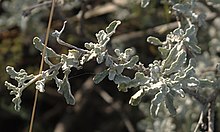Parthenium incanum
| Parthenium incanum | |
|---|---|

| |
| Parthenium incanum growing in Walnut Canyon at Carlsbad Caverns National Park, New Mexico | |
| Scientific classification | |
| Kingdom: | Plantae |
| Clade: | Tracheophytes |
| Clade: | Angiosperms |
| Clade: | Eudicots |
| Clade: | Asterids |
| Order: | Asterales |
| Family: | Asteraceae |
| Genus: | Parthenium |
| Species: | P. incanum
|
| Binomial name | |
| Parthenium incanum | |
Parthenium incanum, with the common names mariola and New Mexico rubber plant, is a plant in the genus Parthenium of the family Asteraceae.[2]
The plant is native to North America, from the Southwestern United States through Northern, Central, and Southwestern Mexico.[2] Habitats include desert grasslands including in the Chihuahuan Desert, on dry gravel slopes, and on plains.
Description
[edit]Parthenium incanum grows from 1.5–3 feet (0.46–0.91 m) in height and width. Its foliage is a pubescent grayish-white. Small white flower clusters appear from July to October.[3]
Uses
[edit]Medicinal
[edit]The Jicarilla Apache used mariola as a traditional medicinal plant. It was prepared by boiling the plant's leaves, and the solution was then rubbed over a pregnant woman's abdomen to relieve discomfort.[4][5]
Cultivation
[edit]Parthenium incanum is cultivated as an ornamental plant, for use in drought tolerant, native plant, and wildlife gardens.[3][6]
References
[edit]- ^ Nova Genera et Species Plantarum 4:260, t. 391. 1820 "Plant Name Details for Parthenium incanum". IPNI. Retrieved June 30, 2010.
- ^ a b "Parthenium incanum". Germplasm Resources Information Network. Agricultural Research Service, United States Department of Agriculture. Retrieved 19 January 2018.
- ^ a b Lady Bird Johnson Wildflower Center Native Plant Information Network (NPIN): Parthenium incanum (mariola)
- ^ University of Michigan at Dearborn: Ethnobotany of Parthenium Incanum
- ^ Opler, Morris E. (1946). Childhood and youth in Jicarilla Apache society. Publications of the Frederick Webb Hodge Anniversary Fund (Vol. 5). Los Angeles: The Southwest Museum Administrator of the Fund.
- ^ Aggie-horticulture.edu—Texas Native Plants Database: Mariola (Parthenium incanum)
External links
[edit]
